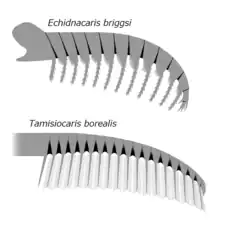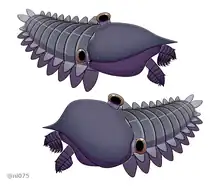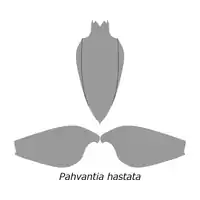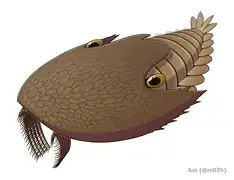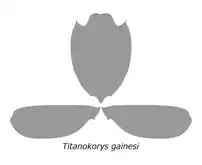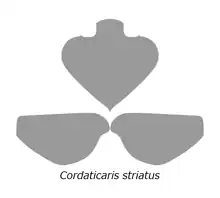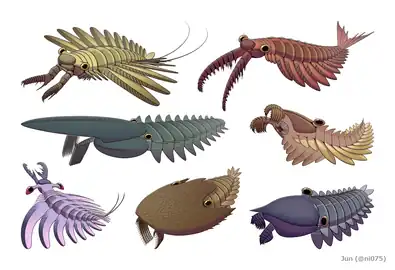Stanleycaris
Stanleycaris is an extinct, monotypic genus of hurdiid radiodont from the middle Cambrian (Miaolingian). The type species is Stanleycaris hirpex. Stanleycaris was described from the Stephen Formation near the Stanley Glacier[1] and Burgess Shale locality of Canada,[2] as well as Wheeler Formation of United States.[3] The genus was characterized by the rake-like frontal appendages with robust inner spines.[4][2]
| Stanleycaris Temporal range: | |
|---|---|
 | |
| Reconstruction of S. hirpex | |
 | |
| Fossil specimens of S. hirpex | |
| Scientific classification | |
| Domain: | Eukaryota |
| Kingdom: | Animalia |
| Phylum: | Arthropoda |
| Class: | †Dinocaridida |
| Order: | †Radiodonta |
| Family: | †Hurdiidae |
| Genus: | †Stanleycaris |
| Species: | †S. hirpex |
| Binomial name | |
| †Stanleycaris hirpex Pates, Daley & Ortega-Hernández (2018) | |
Stanleycaris was originally described only from frontal appendages and oral cone.[3] However, in 2022, 268 specimens of Stanleycaris, many of which were complete, were studied, making Stanleycaris a well documented radiodont.[2] Stanleycaris had three eyes, a bizarre configuration previously unknown among other radiodont genera; yet this head anatomy supports early differentiation among arthropod head and trunk segmentation.[2]
The original description of the taxon appeared in an online supplement to the article published by Jean-Bernard Caron, Robert R. Gaines, M. Gabriela Mángano, Michael Streng and Allison C. Daley in 2010.[1] That description did not satisfy of the requirements of the International Code of Zoological Nomenclature, as the Code did not accept taxa named in electronic publications as validly named until 2012;[3] the name was eventually validated by Pates, Daley & Ortega-Hernández (2018).[5]
Etymology
Its generic name means "Crab of Stanley Glacier"; hirpex, L. "large rake", reflects the rake-like nature of its spiny frontal appendages.[1]
Anatomy
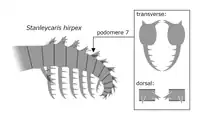 Diagram of frontal appendage
Diagram of frontal appendage- 3D reconstruction of frontal appendages
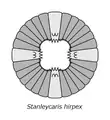 Oral cone
Oral cone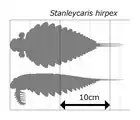 Size estimation
Size estimation
Stanleycaris was a small radiodont, with whole body specimen measured around 1 to 8.3 centimetres (0.39 to 3.27 in), excluding the tail. Even based on the largest, 3 centimetres (1.2 in)-long isolated frontal appendage, the upper body length was thought to be less than 20 centimetres (7.9 in) long.[2] Unlike most hurdiids with large head and broad neck region, the body of Stanleycaris was streamlined like those of anomalocaridids and amplectobeluids.[2]
Head

The small head occupies about 15% of the total body length. Each lateral compound eye was estimated to have around 1000 ommatidia. In addition of a pair of stalked lateral eyes, a third, large median eye was located behind its preocular sclerite (H-element). Similar structures were evident in the fossils of Peytoia and Lyrarapax, suggesting these genera possibly had a median eye too.[2] Contrary to the agreement around mid and late 2010s (based on the discovery of Lyrarapax since 2014) suggest radiodonts had only protocerebrum on their cerebral ganglion,[6] The neuroanatomical evidence of Stanleycaris suggests radiodonts have both protocerebrum and deutocerebrum, and circumesophageal connective that surround digestive system between them.[2] Unlike other radiodonts, the paired lateral sclerites (P-element) are not evident in any Stanleycaris specimens, suggesting they were exclusively absent in this genus.[2]
Frontal appendage
The 1 to 3 centimetres (0.39 to 1.18 in)-long frontal appendages are the most commonly found component of this genus. It comprise 14 segments (podomeres) with 5 long, rake-like curved blades (endites) protruding from the ventral surface of podomere 3–7, while podomere 2 and 9 have short endites.[4] The upper surface bore a row of inner-facing, mostly forked robust spines (gnathites) which are unique to this genus.[4] Similar to Peytoia, the distal podomeres have claw-like dorsal and terminal spines.[4]
Oral cone
The mouth was surrounded by a tetraradial oral cone, which comprises 28 tooth plates instead of 32 like those of other hurdiid genera.[4] Each of the 4 large plate have 2 additional nodes, and the mouth opening has no additional inner plates.[2]
Trunk region
The trunk region have 17 segments with paired lateroventral flaps, as well as 4 caudal filiform blades on the tail. The setal blades (band of gill lamellae) were suggested to be positioned ventrally on each of the trunk segment,[2] contrary to the general reconstruction of radiodont with dorsal setal blades.[7]
Paleoecology
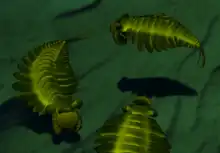
Stanleycaris was most likely a visual predator that specialized primarily on macroscopic, soft-bodied benthic prey. Based on its streamlined body shape and broad trunk flaps, it may have been able to chase relatively fast-moving prey.[2] With strong differentiation of lateral–medial, inner–outer, and proximal–distal morphologies, Stanleycaris was probably able to trap (by using endites), manipulate (by using distal raptorial portion), and masticate (by using gnathites) prey items.[4]
Classification
| |||||||||||||||||||||||||||||||||||||||||||||||||||||||||||||||
| Phylogenetic position of Stanleycaris after Moysiuk & Caron 2022.[2] |
Stanleycaris was analysed to be one of the basalmost hurdiid radiodont, alongside Peytoia and Schinderhannes which shares some anatomical similarities.[8][4][9][2] This suggests that the anomalocaridid/amplectobeluid-like traits (e.g. streamlined body; small head sclerites; frontal appendages with curved dorsal spines) found in these hurdiids represent radiodont ancestral characters.[8][4][2]
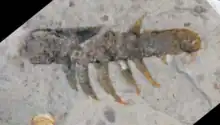 KUMIP 153923
KUMIP 153923
The specimen KUMIP 153923 from the Cambrian Wheeler Formation (Utah, United States), which was described by Robison (1985) as a whole body of new lobopodian species Aysheaia prolata, was reinterpreted as an isolated frontal appendage of Stanleycaris sp. by Pates, Daley & Ortega-Hernández (2017).[10]
See also
References
- Caron, J. -B.; Gaines, R. R.; Mangano, M. G.; Streng, M.; Daley, A. C. (2010). "A new Burgess Shale-type assemblage from the "thin" Stephen Formation of the southern Canadian Rockies". Geology. 38 (9): 811. Bibcode:2010Geo....38..811C. doi:10.1130/G31080.1.
- Moysiuk, Joseph; Caron, Jean-Bernard (2022-07-08). "A three-eyed radiodont with fossilized neuroanatomy informs the origin of the arthropod head and segmentation". Current Biology. 32 (15): 3302–3316.e2. doi:10.1016/j.cub.2022.06.027. ISSN 0960-9822. PMID 35809569. S2CID 250361698.
- José A. Gámez Vintaned; Andrey Y. Zhuravlev (2018). "Comment on "Aysheaia prolata from the Utah Wheeler Formation (Drumian, Cambrian) is a frontal appendage of the radiodontan Stanleycaris" by Stephen Pates, Allison C. Daley, and Javier Ortega-Hernández". Acta Palaeontologica Polonica. 63 (1): 103–104. doi:10.4202/app.00335.2017 (inactive 1 August 2023).
{{cite journal}}: CS1 maint: DOI inactive as of August 2023 (link) - Moysiuk, Joseph; Caron, Jean-Bernard (2021). "Exceptional multifunctionality in the feeding apparatus of a mid-Cambrian radiodont". Paleobiology. 47 (4): 704–724. Bibcode:2021Pbio...47..704M. doi:10.1017/pab.2021.19. ISSN 0094-8373. S2CID 236552819.
- Stephen Pates; Allison C. Daley; Javier Ortega-Hernández (2018). "Reply to Comment on "Aysheaia prolata from the Utah Wheeler Formation (Drumian, Cambrian) is a frontal appendage of the radiodontan Stanleycaris" with the formal description of Stanleycaris". Acta Palaeontologica Polonica. 63 (1): 105–110. doi:10.4202/app.00443.2017.
- Cong, Peiyun; Ma, Xiaoya; Hou, Xianguang; Edgecombe, Gregory D.; Strausfeld, Nicholas J. (2014). "Brain structure resolves the segmental affinity of anomalocaridid appendages". Nature. 513 (7519): 538–542. Bibcode:2014Natur.513..538C. doi:10.1038/nature13486. ISSN 1476-4687. PMID 25043032. S2CID 4451239.
- Van Roy, Peter; Daley, Allison C.; Briggs, Derek E. G. (2015). "Anomalocaridid trunk limb homology revealed by a giant filter-feeder with paired flaps". Nature. 522 (7554): 77–80. Bibcode:2015Natur.522...77V. doi:10.1038/nature14256. ISSN 1476-4687. PMID 25762145. S2CID 205242881.
- Moysiuk, J.; Caron, J.-B. (2019-08-14). "A new hurdiid radiodont from the Burgess Shale evinces the exploitation of Cambrian infaunal food sources". Proceedings of the Royal Society B: Biological Sciences. 286 (1908): 20191079. doi:10.1098/rspb.2019.1079. PMC 6710600. PMID 31362637.
- Caron, J.-B.; Moysiuk, J. (2021). "A giant nektobenthic radiodont from the Burgess Shale and the significance of hurdiid carapace diversity". Royal Society Open Science. 8 (9): 210664. Bibcode:2021RSOS....810664C. doi:10.1098/rsos.210664. PMC 8424305. PMID 34527273.
- Stephen Pates; Allison C. Daley; Javier Ortega-Hernández (2017). "Aysheaia prolata from the Utah Wheeler Formation (Drumian, Cambrian) is a frontal appendage of the radiodontan Stanleycaris". Acta Palaeontologica Polonica. 62 (3): 619–625. doi:10.4202/app.00361.2017.
External links
- "Stanleycaris hirpex". Burgess Shale Fossil Gallery. Virtual Museum of Canada. 2011. Archived from the original on 2020-11-12.
